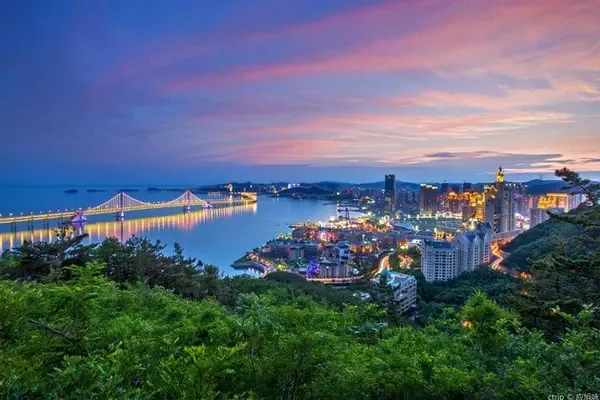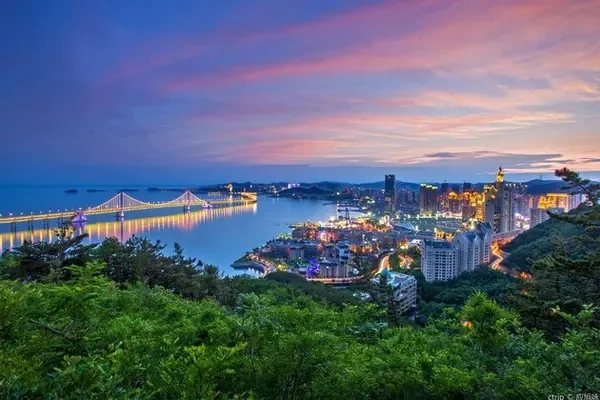After lunch, look for the Dragon King Temple and the Great Dragon Well. Take out your phone and use Baidu navigation. This time, the navigation didn't work again. The route shown on the map should go in a big circle. We had no choice but to ask questions as we walked along the Guancheng River.
This three-hole stone bridge is called "Sanyuan Bridge". There are three stone bridges near the Confucian Temple: "Chongwen Bridge", "Huali Bridge" and "Sanyuan Bridge". The names of the bridges are all related to the imperial examination, which can be regarded as a flattery. In ancient imperial examinations, the first place in the provincial examination was called "Jieyuan", the first place in the general examination was called "Huiyuan", and the first place in the imperial examination was called "Zhuangyuan". Even taking the first place in the three-level examination is called "three yuan in a row", which is the highest honor for scholars. In ancient times, there were very few candidates for Lianzhong Sanyuan, only about twenty or so. Most of the people who even got three grades are not necessarily well-known, so it can be seen that the relationship between test scores and personal achievements may not be very close.
Following the guidance of the locals, we came to the Dragon King Temple facing the Guancheng River. Only then did I realize that the location of Lingquan Temple was not far from Wang Ruofei Square. Should have come here first.
The official name of the Dragon King Temple is "Lingquan Temple". The so-called "Lingquan" refers to the big dragon well under Lingquan Temple. The temple was built in response to the well, and is also named for the spring.
There are many wells in Anshun. In the era when there was no running water, well water was the main source of water for residents. There are three major dragon springs in Anshun: Manger Longjing, which is two miles to the east of the city, is also called "East Dragon Spring"; Longjing Mountain Spring, which is one mile to the west of the city, is also called "Xilongquan"; Dalongjing.
The water of Dalongjing is so sweet that some people even think that this spring is comparable to West Lake Longjing.
Perhaps in order to protect natural resources, Dalongjing is now closed, and the iron gates are locked and no one is allowed to enter. I could only reach in and take two pictures. There is the Dragon King Pavilion on the Dragon Well, where the Dragon King enshrined in the green robe and red face is really majestic. In the old days, when there was a drought, the people of Anshun would come here to pray for the Dragon King to bless the weather.
Lingquan Temple was first built in the Tianqi period of the Ming Dynasty, and what you see now is a new building. The mountain gate of Lingquan Temple is the archway of the Sangu Gate. The forehead above the main gate is inscribed "Lingquan Temple", and the inscriptions on the side gates on both sides are "Entering the Bodhi Gate" and "Climbing the Shore of Nirvana". There are also couplets engraved on both sides of the main entrance: "The lotus on the dragon's back is a clear spring, blessing the earth; the monk recites Amitabha to fill the Buddhist temple, and enlightens all living beings."
There are also inscriptions and couplets on the back of the mountain gate, which are: "Dragon King Temple", "Feng Tiao Yu Shun", "Hai Yan He Qing" and "Dragon rises from Baizhang Lake; rain comes to Jiuchong Tian".
Entering the mountain gate, you can see a memorial archway with two pillars and a single door on the side, and the square title is "well nourished endlessly". There is a stone tablet in the back, inscribed "Nanwu Jingquan Dragon King Bodhisattva's God".
On the front is the Daxiong Palace. The main hall is five rooms wide and hangs on the top of the mountain. There is a front porch in front of the hall. Although the wooden structure of the main hall is newly repaired, its stone pillars are all old.
Standing in front of the Daxiong Hall, you can see the back of the archway in front of the hall:
There is also a three-story pavilion on the high platform on the other side, the upper floor is the Sutra Pavilion, and the lower floor is the Guanyin Hall.
Lingquan Temple is small in scale, but its management is very strict. When entering the door, I actually asked to show the itinerary code, and I looked at it very carefully. In retrospect, I may have been notified of the outbreak in Zunyi.
After the visit, ask the monks about the way to Qingtai Temple. At this time, Baidu navigation once again had problems. The navigation route does not know where to go around.
Following the guidance of passers-by, we walked along the Guancheng River. Only then did we realize that we had taken the wrong road again, because when we were looking for Gu's former residence in the morning, we had already walked this road according to the wrong guidance of the navigation.
Walking on this road for the third time, I felt a little funny. Fortunately, the distance is not far, and finally came to Qingtai nunnery.
It was built in the fifth year of Jiajing in the Ming Dynasty, and the founder of the mountain was the eminent monk Ma Du. But what I can see now seems to be newly repaired. The original cultural relics in the temple, such as the "Huayan Sutra" written in blood, have disappeared. So I turned around and left in a hurry.
Climbing up the slope from Qingtai Temple is the dam of Hongshan Reservoir. Looking down, it is the beautiful Hongshan Lake.
Hongshan Lake Reservoir was built in 1958. Later, Hongshan Lake Park was gradually built around the reservoir, making it a good place for citizens to relax and cool off.
When I came to the lake, I suddenly felt that the mountains and rivers matched each other, and the scenery was infinite. At this time, we were already tired from walking, and there were cruise ships available for rent by the lake, so we could just take a boat tour of the lake. Two elderly people who are nearly eighty years old sailed the cruise ship freely, full of the spirit of "old man chatting with teenagers".
The lake is big enough for an electric boat to roam for an hour. Under the blue sky and white clouds, the calm lake reflects the nearby green mountains, and we are the only cruise ship on the water. The picturesque landscape has become our two world. We cruised slowly on the lake, enjoying the tranquil and beautiful scenery.
We slowly drove towards the Seven-Arch Bridge in the distance. The seven-hole white stone bridge is inlaid on the blue lake like a white jade belt, forming a beautiful picture. Baishi Bridge prohibits cruise ships from passing, so we turned the bow and started to return. There are two more cruise ships on the lake, and the picture begins to feel dynamic.
Just as we were enjoying our tour, the phone rang again. Answering the mobile phone, it was a call from the third brother to report worries—there was another epidemic in Zunyi, Guizhou Province. It seems that a new wave of epidemics has been detonated!
The arrival of the epidemic is inevitable. We resolutely decided that thirty-six strategies are the best strategy. Guizhou tourism plan can only reluctantly give up. It's up to people to plan things, but it's up to God to make things happen. It's really helpless!
Abandon the ship and land in a hurry, ending the tour of the day. After dinner, I went back to the hotel and entrusted my third brother to buy tickets. Fortunately, there are hard sleeper tickets for transit in Shijiazhuang, which is a blessing among misfortunes!
On the morning of the 20th, the hotel has a buffet breakfast. After breakfast, take a taxi to Anshun high-speed railway station.
At Anshun Station, enter the station smoothly with the green code. The train soon arrived at Guiyang North Station. I came to Guiyang 20 years ago. At that time, there was no high-speed rail or North Railway Station.
Guiyang North Railway Station is very large, and the exit passages are empty, showing that there are very few passengers. The exit ticket inspection of the railway is easy, but the epidemic inspection is much stricter.
Check the itinerary code very carefully, check every place you have visited, if Zunyi is included, just leave it directly. After leaving the station, take the subway to Guiyang Station. After arriving at Guiyang Station, I ate two bowls of noodles at "Mr. Li Beef Noodles" next to the station.
The pit stop at Guiyang Station went very smoothly. Because our itinerary codes are all green codes, the inspection is not so careful. Thus began the day and night long sleeper journey. Fortunately, we have long been used to sleeper travel. What is different from the past is that we wear masks all the time except for eating and drinking.
Shijiazhuang transit directly enters the waiting room from the green passage, so it is very convenient.
The high-speed train was one hour late, but fortunately it did not affect our return home. After taking the high-speed rail, I finally returned to Taiyuan after a long journey. The departure from Taiyuan also only checks the itinerary code. After leaving the station, I took a taxi back home. The heating has been sent to the home, and the warmth of the home has a double meaning. We are all very happy. In any case, we have completed another trip.


